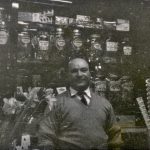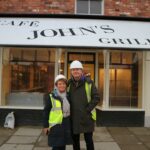Complete
From ice cream and Oxo to rock ‘n’ roll and courting couples, the interior of a popular ice cream parlour has been given a new home in Beamish’s 1950s Town.
John’s Café, from Wingate, County Durham, has been recreated as part of Front Street terrace.
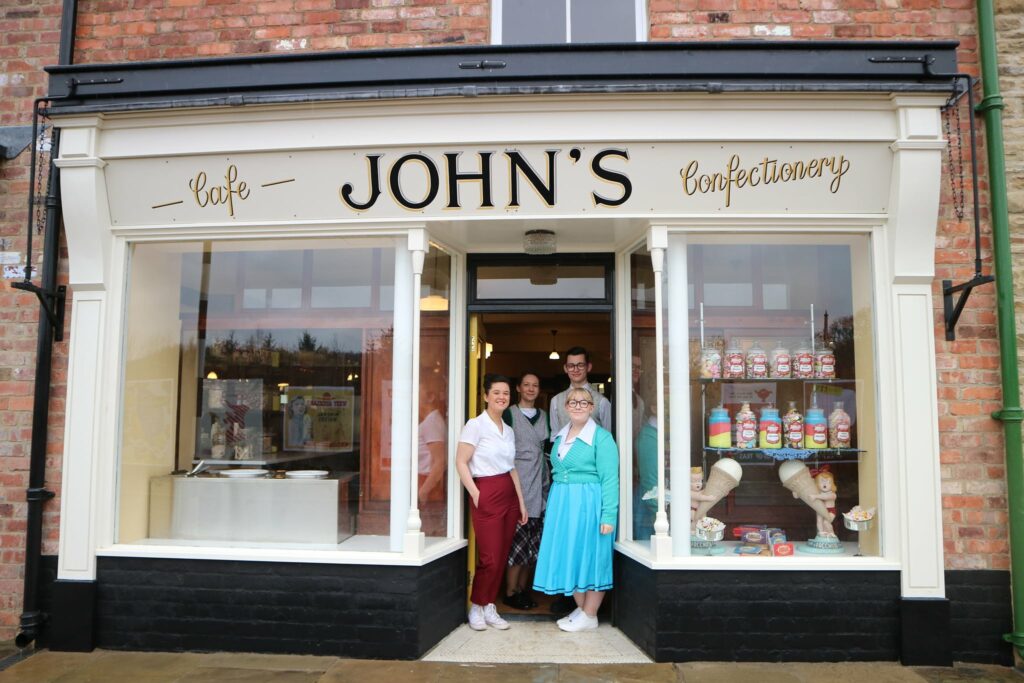
Using original elements from the café, the exhibit will shows a popular 1950s pastime and leisure pursuit, and tells the story of Italian immigration and the impact that many Italian families made by setting up these ice cream parlours.
Visitors to John’s can get ice cream made in a traditional ice cream maker. These machines and the art of ice cream making were imported by Italian families who brought ice cream to the North East of England.
Families can buy ice cream, milkshakes and other treats, listen to the jukebox and sit in the carefully restored and recreated booths, or through the back in the slightly modernised area. There will photographs in the back room showing some of the history of the family-run café through the ages.
Cafés were often the social hub of a town, and were an integral part of many local communities. They were places for people to gather, where courting couples bought ice creams, and offered support to communities – providing a place where unemployed men could meet and where miners on strike could warm up by drinking hot Oxo. They were a fundamental part of small communities. The exhibit tells this important piece of North East history.
As well as the delicious and recognisable treats available in 1950s cafés, such as ice cream sundaes, there were more intriguing sounding options, such as oxtail soup with beefy crisps.
Families worked incredibly hard to produce and sell ice cream, many shops were open from 7am until long gone midnight, seven days a week, including Christmas Day and bank holidays.
John’s Café, once owned by Giovanni Baptista Parisella, known locally as John, was popular with young people in the 1950s, and many Beamish visitors have been keen to share their memories of the building, which closed after John’s death in 2006.
John was of Italian descent but was born in Tranent, near Edinburgh in 1923. John’s family returned to Italy shortly after his birth but moved back to England and settled in Alnwick.
After being demobbed from service in the 7th Battalion King’s Own Scottish Borderers, John worked alongside his father, running a fish and chip restaurant and van. John returned to Italy to meet his future wife, Iva, and, after a short, long-distance romance, returned to marry her. After living in Alnwick for a short while, John bought the café on Front Street, Wingate, in the 1950s.
The café originally opened in 1895 and its distinctive booths were installed in 1925. The glass panels came from Sunderland’s Joblings glassworks and the wooden booths are from Binns in Sunderland. The museum collected the interior of John’s Café in 2013.
We have used carefully restored original elements from the interior of the front of the café, including the window display, seating booths with their marble counter tops and leather seats, as well as some original fixtures like lighting units.
The traditional ice cream machine used to make delicious treats for visitors to buy is from a company called Edoni, which is a family business founded by Italian brothers who immigrated to Scotland. The company is still run by their grandchildren.
The first bricks of the exhibit at Beamish were laid by members of John’s family, including his daughter Maria Ebblewhite and his grandchildren Louisa Crabtree and Mario Parisella. We have worked with John’s family and members of the Wingate community on the recreation.
- John in his café.
- John’s daughter, Maria, and her husband Chris in front of John’s Café at Beamish.
The 1950s Town’s Front Street terrace also includes a hairdresser’s in a replica of an end-terrace shop from Bow Street in Middlesbrough and a fish and chip shop.
No. 2 Front Street is a recreation of the former home of celebrated North East artist Norman Cornish, who lived there from 1953 to 1967. The exhibit also tells the story of the Spennymoor Settlement, which was part of a wider national movement and nurtured the talents of artists, writers and poets including Norman, Tom McGuinness, Bob Heslop and Bert Dees, and playwright Sid Chaplin among others.
If you have any memories of John’s Café, Beamish would love to hear from you. Contact Geraldine Straker, Remaking Beamish Community Participation Officer, email: geraldinestraker@beamish.org.uk.
The Design of John’s
John’s Café was really well known in the Wingate area. From the 1890s it was a café, the interior was redone in the 1920s and it was bought by John and his family in the 1950s.
This is really important to the story we are sharing at Beamish, by the 1950s the interior hadn’t been updated very much and was still 1920s in style with dark wood panelling, we have recreated this 1920s style to ensure the exhibit is as authentic as possible.
The front of the shop has been painted in off-white and black paint, along the bottom of the walls below the pillars has been painted black, and the front door is painted in yellow gloss.
All the colours we have used match the colours seen in original photos of John’s Café, and an awning has been recreated to match the original.
In the entranceway to John’s was a mosaic tiled floor. It is fairly simple in design, being small square pieces of marble and we worked with John’s family to replicate this.
Internally, the walls are all original dark wood, high-sided panelling and the seating booths from the original café separate this area into cosy individual dining spots. The rear seating section has been “modernised” and the walls are covered in a textured wallpaper.

The ceilings of the original café were wallpapered with textured Anaglypta wallpaper and we have recreated this look. The front room and the rear room of the café at Beamish have been papered in two slightly different prints, a subtle difference indicating the newer update to the rear. This was inspired by The University Café in Glasgow, an Italian owned café of a similar age to John’s and laid out in two distinct sections much like our exhibit is.
The main counter in John’s is stained dark wood and has a marble top. All other internal woodwork is also darkly stained to create an older feel, this matches what was originally in John’s Café. The toilet doors are dark wood, 1930s-style, one over three panel doors. These have brass WC signs and brass locks.
The main floor finish through the visitor seating area in John’s Café is terrazzo flooring to match what was originally in John’s. The rear entrance/exit lobby of the café has been tiled in terracotta tiles, just as it was in the original café.
Related Exhibits
No. 2 Front Street
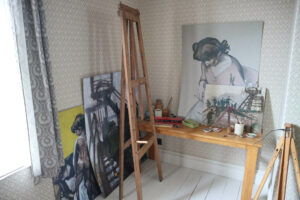
No. 2 Front Street is a recreation of the former home of North East artist Norman Cornish and tells the story of the Spennymoor Settlement of artists, writers and poets.
Read moreMiddleton's Quality Fish and Chips
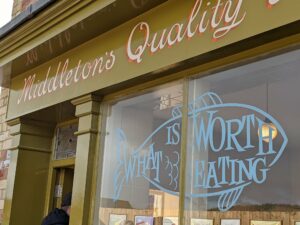
A fried fish shop has been replicated in The 1950s Town to serve up this popular 1950s treat.
Read moreElizabeth's Hairdresser's
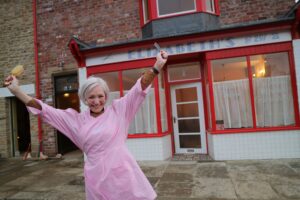
Hairspray, hours of sitting underneath a hairdryer and tricky home perms, hair was big in the 1950s… literally!
Read more
